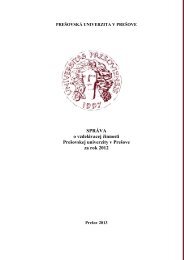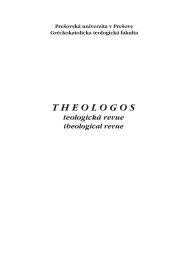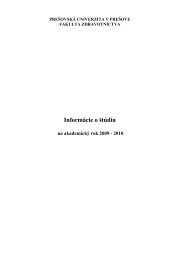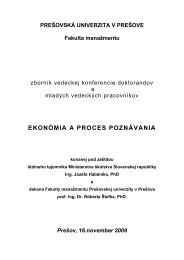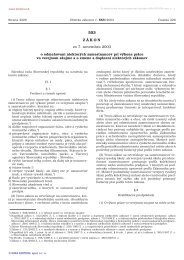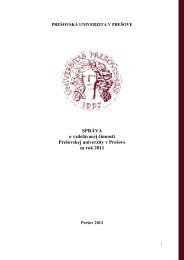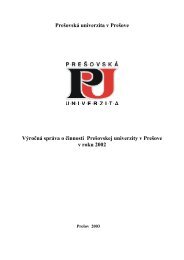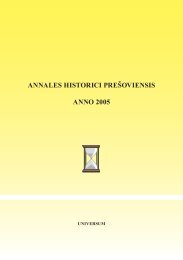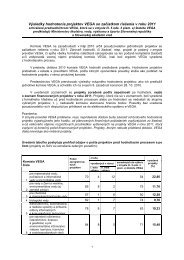T H E O L O G O S - Prešovská univerzita v Prešove
T H E O L O G O S - Prešovská univerzita v Prešove
T H E O L O G O S - Prešovská univerzita v Prešove
You also want an ePaper? Increase the reach of your titles
YUMPU automatically turns print PDFs into web optimized ePapers that Google loves.
Bożena Drzewicka<br />
Though, a fact to be taken into account was the differentiated legal<br />
dependence of the member states. For that reason, in Par. 5 of the Preamble<br />
to the Charter of Fundamental Rights only the European Union<br />
Treaty, the European Convention on the Protection of Human Rights and<br />
Fundamental Freedoms, and the earlier Community Treaties are mentioned.<br />
Together with Arts. 52 and 53 of the Charter those references should<br />
be viewed as ones providing for an unambiguous extent of the European<br />
protection of human rights, which must be produced as much as it is<br />
guaranteed in the Convention. What emerges in a normative system of<br />
human rights for Europe. Its foundations are the constitutions of the number<br />
states as well as the Strasbourg and Luxembourg systems. However,<br />
the normative system in question does not seem to be uniform 38 . One can<br />
ask how an individual living to Europe whose rights are protected by<br />
many instruments, takes advantage of the rights and wonder if the European<br />
protection model could become attractive for other cultures and<br />
civilizations.<br />
In the EU, the fundamental rights are treated as absolutely necessary.<br />
These rights are guaranteed by institutions and organs of the EU (or the<br />
Communities) as well as by the Council of Europe. Everyone can take<br />
advantage of the rights and no limitations should be initiated. According<br />
to Par. 6, the use of the rights involves a responsibility and certain obligations<br />
with respect to other people, mankind and future generations. Thus<br />
the human rights and freedoms have a close connection to responsibility<br />
and duties towards people and towards the common good 39 . A modern<br />
dualistic conception is reflected here. The basic rule of the Union is the<br />
protection of fundamental rights. If has a political and a moral discussion,<br />
and legitimizes any other EU activity. It is declared that the principles of<br />
human dignity, liberty, equality and solidarity 40 are the Union’, foundations.<br />
A subsequent reference is that to “common values” as a basis for<br />
the security and peace of each European nation. Taking this into account<br />
the Union develops different partnerships that contribute to the creation<br />
of a common area of peace, stability and welfare. The area aimed at is<br />
to include the Asian Middle East as well as Northern Africa within the<br />
38<br />
C. Mik, Koncepcja normatywna prawa europejskiego praw człowieka. Toruń 1993, p.<br />
21-30, cont.<br />
39<br />
Updated Explanations relating to the text of the Charter of Fundamental Rights. CONV<br />
828/1/03 REV1 Brussels 18.07.2003; For a detailed discussion see: D. Hübner, Czy dobro<br />
Europy jest dobrem Polski? In: Dobro wspólne. Forum Dialogu. Gdański Areopag.<br />
Gdańsk 2001, p. 56-62, and the debate on p. 10-41.<br />
40<br />
The Charter…, ibidem p. 7. In the draft, the term „principles” had been used; his was<br />
substituted by „common values”.<br />
36



